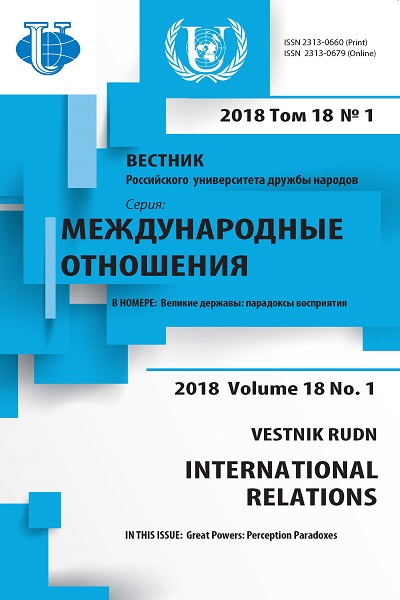The problem of the Russian Federation image formation by German think tanks in the context of the Syrian crisis (case of Friedrich-Ebert-Stiftung)
- Authors: Ivkina N.V.1
-
Affiliations:
- RUDN University (Peoples’ Friendship University of Russia)
- Issue: Vol 18, No 1 (2018): Great Powers: Perception Paradoxes
- Pages: 96-106
- Section: THEMATIC DOSSIER
- URL: https://journals.rudn.ru/international-relations/article/view/18379
- DOI: https://doi.org/10.22363/2313-0660-2018-18-1-96-106
- ID: 18379
Cite item
Full Text
Abstract
The relevance of the research topic due to the ever-increasing role of the analytical institutions in the process of formation of Russia’s image in the public consciousness. In this context, the position of Germany represents the greatest interest. Germany is a state, on the one hand, a NATO member, on the other hand, represents one of the main European partners of Russia. This prevents it to form a clear-cut stance on issues directly related to Russia and Germany, on issues in solving which involved both countries. The aim of the study is to identify the role of think tanks of Germany in the process of forming the image of Russia, and also the degree of influence of research and analytical centers on the media. The subject of research was the problem of the Syrian crisis. For example, the Friedrich Ebert Foundation implemented a study to identify interest centers in shaping the image of Russia in the framework of solving the Syrian crisis. As research methods is to provide a description method used for studying the materials of the Fund, the method of comparison for the choice of the object of study, and to determine the effect of center content on various media. For wider exploration of topics in addition to the materials analytical centers were used for more of the Russian and foreign literature, as well as the materials of the statistical agencies. The results of the study represent a number of conclusions, which show the degree of interest of the Friedrich Ebert Foundation in the process of formation of Russia’s image and prospects of implementing the ideas of the analytical center in the German news system.
About the authors
Natalia Viktorovna Ivkina
RUDN University (Peoples’ Friendship University of Russia)
Author for correspondence.
Email: ivkina_nv@rudn.university
Assistant of the Department of Theory and History of International Relations, Peoples’ Friendship University of Russia (RUDN University)
References
- Abbrams, E. (2011). Russia + Syria + Hezbollah = Hamas. Council on Foreign Relations. URL: https://www.cfr.org/blog/russia-syria-hezbollah-hamas (accessed: 20.12.2017).
- Basarenko, T.V. (2014). The role of regional aspects of international relations in Spanish basic analytical centers’ researches. Vestnik RUDN. International Relations, (2), 148—157. (In Russ.).
- Dominique, D. (n/a). Que faire de la Russie? Que faire avec la Russie? IFRI. URL: http://www.ifri.org/ sites/default/files/atoms/files/actuelle_david_que_faire_de_la_russie.pdf (accessed: 20.12.2017).
- Ivkina, N.V. & Petrovich-Belkin, O.K. (2013). U.S. — France Counterterrorism Cooperation. Vestnik RUDN. International Relations, (2), 39—46. (In Russ.).
- Ivkina, N.V. & Poyda, A.A. (2015). Position of the American Think Tanks on Iran’s Nuclear Program. Vestnik RUDN. International Relations, 15 (3), 118—125. (In Russ.).
- Ivkina, N.V. & Marakhovsky, E.L. (2016). The withdrawal of Russian MSF from Syria: new hope for the western media. RISS. URL: https://riss.ru/analitycs/29188/ (accessed: 20.12.2017). (In Russ.).
- Kosov, A.P. (2016). The USA and “The Arab Spring”: evaluations of the Russian expert community. Vestnik RUDN. International Relations, 16 (3), 473—481. (In Russ.).
- Kurylev, K.P., Ngoyan, A.L., Palacios, E.P. & Skudina, O.V. (2016). Unsettled conflicts in the Post-Soviet space in the analysis of the western research centers. Vestnik RUDN. International Relations, 16 (3), 482—493. (In Russ.).
- Kingdon, J.W. (2011). Agendas, Alternatives, and Public Policies. Boston: Longman.
- McGann, J.G. (2017). 2016 Global go to think tank index report. University of Pennsylvania ScholarlyCommons. URL: https://repository.upenn.edu/cgi/viewcontent.cgi?article=1011&context= think_tanks (accessed: 20.12.2017).
- Petrov, E.V. “The Russian theme” in the West. Dictionary-reference book on American Russian studies. Saint Petersburg: Izdatel’stvo SPb im. V.B. Bobkova filiala Rossijskoj tamozhennoj akademii, 1997. (In Russ.).
- Shakleina, T.A. (2015). Conceptualization of US policy toward Russia in the 2000s. In: Foreign Studies of Russia. Textbook. Ed. by A.B. Bezborodova. Moscow: Prospectus, p. 328—370. (In Russ.).
- Sestanovich, S. (2015). Russia’s Campaign in Syria: Three Things to Know. Council on Foreign Relations. URL: https://www.cfr.org/explainer-video/russias-campaign-syria-three-things-know (accessed: 20.12.2017).
- Wieland, C. (2011). Between Democratic Hope and Centrifugal Fears. Syria’s Unexpected Open-ended Intifada. Friedrich Ebert Stiftung. URL: http://library.fes.de/pdf-files/ipg/2011-4/07_ a_wieland_eng.pdf (accessed: 20.12.2017).
Supplementary files










